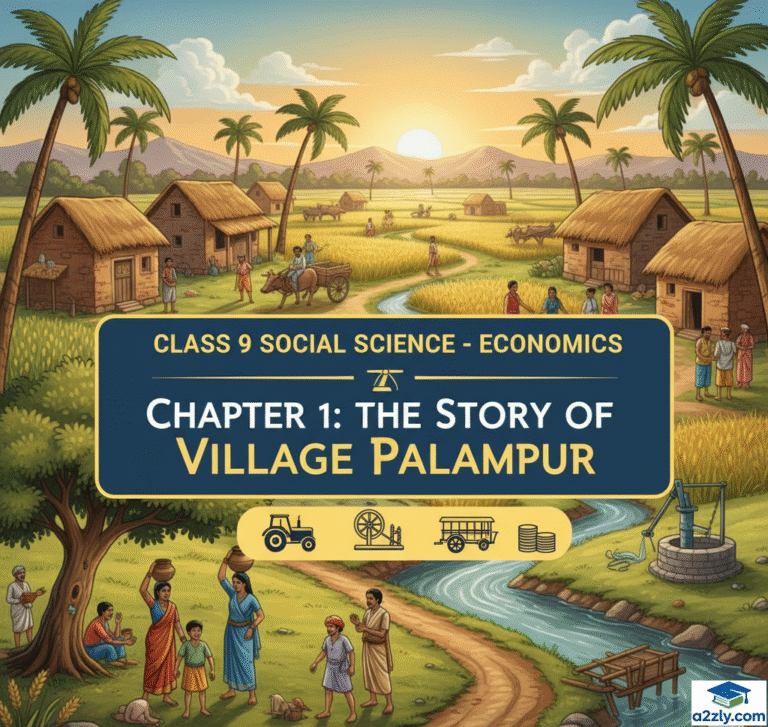1. Short Notes for Revision
- Overview and Village Setup: Hypothetical village Palampur illustrates production. Main activity: Farming (75% dependent). 450 families; upper caste own majority land, SCs (1/3) in small houses. Connected by road to Raiganj/Shahpur; transport: Carts to trucks. Facilities: Electricity (tubewells/business), schools (2 primary, 1 high), health centre/dispensary.
- Organisation of Production: Aim: Produce goods/services. Factors: Land (natural resources). Labour (skilled/unskilled workers). Physical capital – Fixed (tools/machines/buildings used over years); Working (raw materials/money used up). Human capital (knowledge/enterprise).
- Farming in Palampur: Fixed land (240 ha cultivated, no expansion since 1960). Increase output via multiple cropping (3 crops/year: Jowar/bajra, potato, wheat). Green Revolution (1960s): HYV seeds, fertilizers, pesticides, tubewells (200 ha irrigated).
- Land Distribution: Unequal; 150 landless, 240 small (<2 ha), 60 medium/large (>2 ha). Small use family labour; large hire, have surplus.
- Labour and Wages: Farm labourers (landless/small holders, mostly dalits); wages below minimum (Rs 115-120 vs Rs 300/day). Underemployment; seek non-farm work.
- Capital in Farming: Small borrow at high interest (24%); large use savings. Modern methods need more capital (tubewells/tractors).
- Non-Farm Activities: 25% involved. Dairy (milk sales), small manufacturing (jaggery crushing), shop-keeping (general stores), transport (rickshaws/tractors). Require capital; create jobs.
- Surplus and Sustainability: Large farmers save, invest; small in debt. Modern methods overused land (soil fertility loss, groundwater depletion). Need careful resource use.
2. Multiple Choice Questions (MCQs)
- Palampur is connected to Raiganj by: A) Railway B) All-weather road C) River D) Footpath
- Number of families in Palampur: A) 350 B) 450 C) 550 D) 650
- Main production activity: A) Manufacturing B) Farming C) Transport D) Trade
- Factors of production: A) 3 B) 4 C) 5 D) 2
- Fixed capital example: A) Seeds B) Tractor C) Money D) Fertilizers
- Working capital example: A) Building B) Raw materials C) Plough D) Land
- Land under cultivation: A) Expanding B) Fixed C) Decreasing D) Variable
- Multiple cropping: A) One crop/year B) Two crops/year C) Three crops/year D) Four crops/year
- Green Revolution year in Palampur: A) 1950 B) 1960 C) 1970 D) 1980
- HYV seeds need: A) Less water B) Plenty of water C) No water D) Rain only
- Small farmers percentage: A) 240 families B) Majority C) Landless D) Large
- Farm labourers wages: A) Rs 300/day B) Rs 115-120/day C) Rs 400/day D) Rs 200/day
- Non-farm percentage: A) 75% B) 50% C) 25% D) 10%
- Dairy is: A) Farm activity B) Non-farm C) Manufacturing D) Trade
- Mishrilal’s unit: A) Dairy B) Jaggery manufacturing C) Transport D) Shop
- Kareem’s centre employs: A) 1 B) 2 C) 3 D) 4
- Environmental issue: A) Soil fertility loss B) More land C) Less water D) Traditional methods
- Surplus use by large farmers: A) Consume all B) Save/invest C) Borrow D) Waste
- Human capital: A) Machines B) Knowledge C) Land D) Money
- Palampur resembles: A) Eastern UP B) Western UP C) Southern UP D) Northern UP
Answer Key: 1-B, 2-B, 3-B, 4-B, 5-B, 6-B, 7-B, 8-C, 9-B, 10-B, 11-B, 12-B, 13-C, 14-B, 15-B, 16-C, 17-A, 18-B, 19-B, 20-B
3. Very Short Answer Type Questions (VSAQs)
- What is Palampur? Answer: Hypothetical village for production concepts.
- Population dependent on farming? Answer: 75%.
- Define land factor. Answer: Natural resources like water, forests.
- Fixed capital? Answer: Tools, machines, buildings used over years.
- Working capital? Answer: Raw materials, money used up.
- Human capital? Answer: Knowledge, enterprise.
- Land status? Answer: Fixed since 1960.
- Multiple cropping? Answer: More than one crop/year.
- Green Revolution? Answer: Modern farming with HYV, chemicals.
- Irrigated area? Answer: 200 hectares.
- Small farmers? Answer: Cultivate <2 ha; 240 families.
- Farm labourers? Answer: Landless/small holders; low wages.
- Dairy? Answer: Non-farm; sell milk.
- Mishrilal’s business? Answer: Jaggery manufacturing.
- Non-farm percentage? Answer: 25%.
4. Short Answer Type Questions (SAQs)
- Describe Palampur. Answer: Fairly developed; road, electricity, schools, health facilities. 450 families; unequal land. Compare to your village.
- Factors of production? Answer: Land (natural), labour (workers), physical capital (fixed/working), human capital (knowledge). Essential for goods/services.
- Land fixed how? Answer: No expansion; increase output via multiple cropping/modern methods.
- Multiple cropping? Answer: Grow jowar/bajra, potato, wheat yearly. Uses irrigation efficiently.
- Green Revolution role? Answer: HYV seeds, tubewells increased yield 3x. Benefited large farmers.
- Land distribution? Answer: Unequal; 150 landless, 240 small, 60 large. Small struggle; large prosper.
- Farm labourers? Answer: Dalits/landless; wages low due excess supply. Underemployed.
- Capital types? Answer: Fixed (tractors), working (seeds). Large use savings; small borrow.
- Dairy? Answer: Rear buffaloes, sell milk. Steady non-farm income.
- Small manufacturing? Answer: Family-based; Mishrilal’s jaggery unit. Low capital.
- Shop-keeping? Answer: Sell daily goods; small scale.
- Transport? Answer: Vehicles ferry goods/people; Kishora’s tractor example.
- Surplus use? Answer: Large save, lend, invest; small consume/borrow.
- Sustainability issues? Answer: Chemical overuse depletes soil/water. Need careful use.
- Non-farm expansion? Answer: Loans, training, infrastructure to absorb labour.
5. Long Answer Type Questions (LAQs)
- Explain production organisation. Answer: Needs land (fixed natural), labour (abundant), physical capital (scarce, fixed/working), human capital. In Palampur, farming combines for crops. Small farmers lack capital, borrow; large invest surplus. Non-farm like dairy uses minimal capital. Factors interdependent; scarcity affects small producers.
- Discuss farming methods evolution. Answer: Traditional: Cow-dung, Persian wheels, low yield. Modern (Green Revolution 1960s): HYV seeds, fertilizers, tubewells, tractors. Increased wheat from 1300 to 3200 kg/ha. Multiple cropping 3 crops/year. But overuses resources; soil depletion, groundwater fall. Sustainable balance needed.
- Analyze land/labour/capital role. Answer: Land fixed constraint; increase via methods. Labour abundant, low wages, underemployment. Capital scarce for small; borrow high interest (24%). Large use surplus for tractors/tubewells. Human capital applies knowledge. Inequality: Large prosper, small in debt/poverty.
- Non-farm activities importance. Answer: 25% involved; dairy (milk sales), manufacturing (jaggery), shops, transport. Require capital (loans/savings). Create jobs for labourers. In region, similar; expand via government support. Reduce farming pressure, absorb surplus labour, promote growth.
- Farm labourers’ conditions. Answer: Landless/small, dalits; compete for work, wages Rs 115-120 vs minimum 300. Debt from loans. Dala/Ramkali example: Irregular, low pay. Need education, non-farm options. Highlights rural inequality; land reform key.
- Sustainability in farming. Answer: Modern methods boost yield but deplete soil (chemicals kill microbes), groundwater (tubewells). Reports show Punjab’s degradation. Solutions: Organic farming, rainwater harvesting. Palampur example warns overuse; balance production with conservation for future.
6. Source-Based / Case-Based Assessment Questions
Source Extract: (From textbook) The aim of production is to produce the goods and services that we want. There are four requirements… first land… second labour… third physical capital (tools, machines, buildings fixed; raw materials, money working)… fourth knowledge and enterprise (human capital).
Questions:
- Production aim?
- Name factors.
- Fixed capital?
- Working capital?
- Human capital?
- Why important?
Answer Key:
- Goods/services wanted.
- Land, labour, physical/human capital.
- Tools/machines/buildings.
- Raw materials/money.
- Knowledge/enterprise.
- Combine resources for output.
Source Extract: (Green Revolution) The Green Revolution… HYV seeds promised greater grain… needed plenty of water, chemical fertilizers, pesticides… farmers in Punjab, Haryana, Western UP first… high yields.
Questions:
- When introduced?
- Key features?
- Benefits?
- Requirements?
- Who benefited?
Answer Key:
- Late 1960s.
- HYV seeds, chemicals, irrigation.
- Higher yields.
- Water, capital.
- Medium/large farmers.
Source Extract: (Land distribution) One third landless (150 families). Remaining: 240 small (<2 ha), 60 medium/large. Small plots inadequate income.
Questions:
- Landless families?
- Small farmers?
- Medium/large?
- Impact on small?
- Inequality cause?
- Suggest solution.
Answer Key:
- 150.
- Low income, debt.
- Unequal ownership.
- Land reform/redistribution.
7. Solved Exercise-End Questions (NCERT Solutions)
- Every village in India is surveyed once in ten years during the Census… Fill based on Palampur. Answer: a. Location: Western UP. b. Total area: Not specified (cultivated 240 ha). c. Land use: Cultivated 240 ha (200 irrigated, 40 unirrigated); non-cultivable (dwellings/roads). d. Facilities: Educational (2 primary, 1 high school); Medical (health centre, dispensary); Market (shops); Electricity (tubewells/business); Communication (road); Nearest town (Shahpur).
- Modern farming methods require more inputs which are manufactured in industry. Do you agree? Answer: Yes. HYV seeds, fertilizers, pesticides, machinery like tractors from industries. Tubewells need electricity/equipment. Traditional used local resources; modern depend on industrial inputs for yield.
- How did the spread of electricity help farmers in Palampur? Answer: Powered tubewells irrigating 200 ha reliably. Enabled multiple cropping, higher yields. Used in small business like jaggery crushing. Improved living via fans/lights.
- Is it important to increase the area under irrigation? Why? Answer: Yes. Only 40% India irrigated; rest rain-dependent, risky. Increases yield, multiple cropping, food security. Palampur: Irrigation key to Green Revolution success.
- Construct a table on the distribution of land among the 450 families of Palampur. Answer: (Table): Category – Families – Land (ha); Landless – 150 – 0; Small (<2) – 240 – <480 total; Medium/large (>2) – 60 – >1200 total. Shows inequality.
- Why are the wages for farm labourers in Palampur less than minimum wages? Answer: Excess labour supply; competition. Minimum Rs 300/day but paid Rs 115-120. Landless depend on daily work; no unions/bargaining.
- In your region, talk to two labourers… What wages? Happy? Why? Answer: (Sample): Farm: Rs 200/day cash, irregular, unhappy due low pay. Construction: Rs 500/day, happy but hard/physical risk. Need better conditions.
- What are the different ways of increasing production on the same piece of land? Use examples. Answer: Multiple cropping (3 crops/year like Palampur). Modern methods (HYV, fertilizers). Examples: Wheat after potato; irrigation enables.
- Describe the work of a farmer with 1 hectare of land. Answer: Small farmer; family labour. Borrows for seeds/fertilizers. Multiple cropping for max output. Low surplus; debt cycle. Hard manual work; seeks extra jobs.
- How do the medium and large farmers obtain capital for farming? How is it different from the small farmers? Answer: From savings/surplus sales. Invest in machinery. Small borrow from moneylenders at high interest (24%), distress to repay. Large self-reliant.
- On what terms did Savita get a loan from Tejpal Singh? Would Savita’s condition be different if she could get a loan from the bank at a low rate of interest? Answer: Rs 3000 at 24% for 4 months; work as labourer at Rs 100/day. Bank loan low interest (8-10%), no labour condition; easier repayment, less distress.
- Talk to some old residents… changes in irrigation and production methods during the last 30 years. Answer: (Sample report): Irrigation from canals/tubewells vs rain. Methods: HYV/tractors vs traditional. Yields higher but costs up, soil degraded.
- What are the non-farm production activities taking place in your region? Make a short list. Answer: Dairy, agro-processing, shops, transport, tuition, handicrafts. Provide alternatives to farming.
- What can be done so that more non-farm production activities can be started in villages? Answer: Cheap loans, skill training, infrastructure (roads/power), market linkages. Government schemes for rural enterprises. Reduce migration, employ locals.

